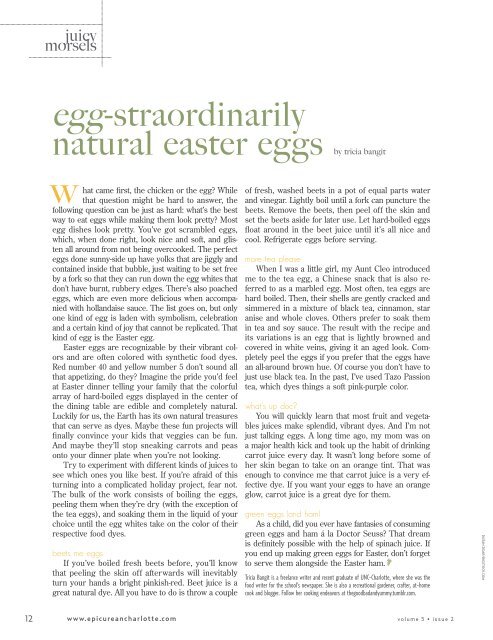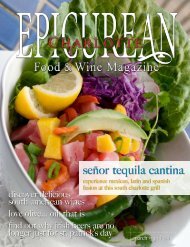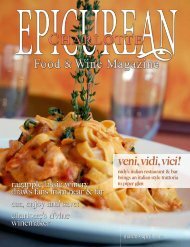Here - Epicurean Charlotte Food & Wine Magazine
Here - Epicurean Charlotte Food & Wine Magazine
Here - Epicurean Charlotte Food & Wine Magazine
You also want an ePaper? Increase the reach of your titles
YUMPU automatically turns print PDFs into web optimized ePapers that Google loves.
juicy<br />
morsels<br />
egg-straordinarily<br />
natural easter eggs<br />
w<br />
hat came first, the chicken or the egg? While<br />
that question might be hard to answer, the<br />
following question can be just as hard: what’s the best<br />
way to eat eggs while making them look pretty? Most<br />
egg dishes look pretty. You’ve got scrambled eggs,<br />
which, when done right, look nice and soft, and glisten<br />
all around from not being overcooked. The perfect<br />
eggs done sunny-side up have yolks that are jiggly and<br />
contained inside that bubble, just waiting to be set free<br />
by a fork so that they can run down the egg whites that<br />
don’t have burnt, rubbery edges. There’s also poached<br />
eggs, which are even more delicious when accompanied<br />
with hollandaise sauce. The list goes on, but only<br />
one kind of egg is laden with symbolism, celebration<br />
and a certain kind of joy that cannot be replicated. That<br />
kind of egg is the Easter egg.<br />
Easter eggs are recognizable by their vibrant colors<br />
and are often colored with synthetic food dyes.<br />
Red number 40 and yellow number 5 don’t sound all<br />
that appetizing, do they? Imagine the pride you’d feel<br />
at Easter dinner telling your family that the colorful<br />
array of hard-boiled eggs displayed in the center of<br />
the dining table are edible and completely natural.<br />
Luckily for us, the Earth has its own natural treasures<br />
that can serve as dyes. Maybe these fun projects will<br />
finally convince your kids that veggies can be fun.<br />
And maybe they’ll stop sneaking carrots and peas<br />
onto your dinner plate when you’re not looking.<br />
Try to experiment with different kinds of juices to<br />
see which ones you like best. If you’re afraid of this<br />
turning into a complicated holiday project, fear not.<br />
The bulk of the work consists of boiling the eggs,<br />
peeling them when they’re dry (with the exception of<br />
the tea eggs), and soaking them in the liquid of your<br />
choice until the egg whites take on the color of their<br />
respective food dyes.<br />
beets me eggs<br />
If you’ve boiled fresh beets before, you’ll know<br />
that peeling the skin off afterwards will inevitably<br />
turn your hands a bright pinkish-red. Beet juice is a<br />
great natural dye. All you have to do is throw a couple<br />
by tricia bangit<br />
of fresh, washed beets in a pot of equal parts water<br />
and vinegar. Lightly boil until a fork can puncture the<br />
beets. Remove the beets, then peel off the skin and<br />
set the beets aside for later use. Let hard-boiled eggs<br />
float around in the beet juice until it’s all nice and<br />
cool. Refrigerate eggs before serving.<br />
more tea please<br />
When I was a little girl, my Aunt Cleo introduced<br />
me to the tea egg, a Chinese snack that is also referred<br />
to as a marbled egg. Most often, tea eggs are<br />
hard boiled. Then, their shells are gently cracked and<br />
simmered in a mixture of black tea, cinnamon, star<br />
anise and whole cloves. Others prefer to soak them<br />
in tea and soy sauce. The result with the recipe and<br />
its variations is an egg that is lightly browned and<br />
covered in white veins, giving it an aged look. Completely<br />
peel the eggs if you prefer that the eggs have<br />
an all-around brown hue. Of course you don’t have to<br />
just use black tea. In the past, I’ve used Tazo Passion<br />
tea, which dyes things a soft pink-purple color.<br />
what’s up doc?<br />
You will quickly learn that most fruit and vegetables<br />
juices make splendid, vibrant dyes. And I’m not<br />
just talking eggs. A long time ago, my mom was on<br />
a major health kick and took up the habit of drinking<br />
carrot juice every day. It wasn’t long before some of<br />
her skin began to take on an orange tint. That was<br />
enough to convince me that carrot juice is a very effective<br />
dye. If you want your eggs to have an orange<br />
glow, carrot juice is a great dye for them.<br />
green eggs (and ham)<br />
As a child, did you ever have fantasies of consuming<br />
green eggs and ham á la Doctor Seuss? That dream<br />
is definitely possible with the help of spinach juice. If<br />
you end up making green eggs for Easter, don’t forget<br />
to serve them alongside the Easter ham.E<br />
Tricia Bangit is a freelance writer and recent graduate of UNC-<strong>Charlotte</strong>, where she was the<br />
food writer for the school’s newspaper. She is also a recreational gardener, crafter, at-home<br />
cook and blogger. Follow her cooking endeavors at thegoodbadandyummy.tumblr.com.<br />
Dušan Zidar/bigstock.com<br />
8 Ways to Make<br />
Organic <strong>Food</strong> Coloring<br />
Orange<br />
Carrots are your best bet for<br />
a perfectly peachy tint. Just juice<br />
them (or buy fresh carrot juice),<br />
and don’t worry about the flavor.<br />
Carrots are naturally sweet.<br />
Yellow<br />
For yellow, you’ll need to hit the<br />
spice rack. Both saffron flowers<br />
and turmeric powder will create<br />
that sunny, summery hue. These<br />
are each intensely-colored spices,<br />
so a little goes a long way. Still,<br />
be careful—start with very small<br />
amounts, and taste as you add.<br />
Green<br />
Are you forever trying to find<br />
ways to get greens into your<br />
kids? How about spinach! A<br />
little spinach will work like a<br />
charm and doesn’t impart<br />
any flavor at all (PROMISE!).<br />
Blue and Purple<br />
Blues and purples can be a bit<br />
harder, but they are certainly<br />
possible. Red cabbage can be<br />
used to make both purple and<br />
blue food coloring. For the former,<br />
cut and boil the cabbage<br />
until the water is very dark and<br />
concentrated. This will give you<br />
a pretty purple dye. For the<br />
latter, slowly stir in baking soda,<br />
a bit at a time. It will react with<br />
the cabbage juice and produce<br />
a perfectly pretty blue hue.<br />
Working with natural coloring<br />
will be different than the artificially<br />
colors you’re probably used<br />
to. In general you can expect<br />
a paler, more pastel-type of<br />
result. It is best if you experiment,<br />
add a little at a time,<br />
and always taste as you go.<br />
12 www.epicureancharlotte.com volume 5 • issue 2 epicurean charlotte food & wine march • april 2013 13












